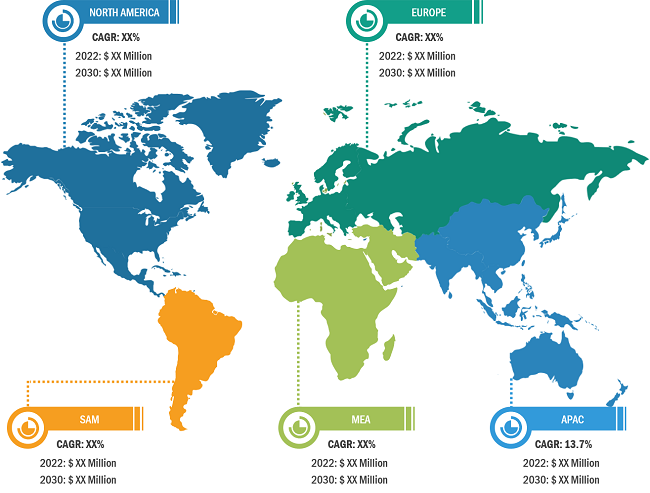Growing Adoption of AI-based Vision Sensors to Create Lucrative Opportunities in Vision Sensors Market During 2022–2030
According to our latest market study on " Vision Sensors Market Size and Forecast (2020–2030), Global and Regional Share, Trend, and Growth Opportunity Analysis – by Type, Application, and Industry Vertical," the market was valued at US$ 3.28 billion in 2022 and is expected to reach US$ 8.33 billion by 2030; it is estimated to record a CAGR of 12.4% from 2022 to 2030.
Artificial intelligence (AI) has demonstrated to be a significant revolutionary element in the next digital era, and is expected to generate opportunities for the growth of the vision sensors market. Businesses are attempting to increase enterprise use case accessibility to AI, and many companies use AI technology to enhance client satisfaction. Access to historical datasets is the most crucial factor accelerating the high innovation with AI. Since data recovery and storage have grown more affordable, many industries, including healthcare facilities and government organizations, have created unstructured data available to the research community. AI supports researchers to access rich information, ranging from historical rainfall trends to clinical imaging. Researchers and information scientists are encouraged to innovate more quickly by the vast datasets accessible through next-generation computer architectures is boosting the vision sensors market. Growing adoption associated with significant benefits offered by AI technology to the industries is creating opportunities in the vision sensors market growth.
Vision Sensors Market — by Geography, 2022
Vision Sensor Market Size and Forecast (2020 - 2030), Global and Regional Share, Trend, and Growth Opportunity Analysis Report Coverage: By Type (Less than 3D and 3D), Application (Inspection, Gauging, Code Reading, and Others), and Industry Vertical (Automotive, Electronics, Industrial Manufacturing, Food & Beverages, and Others), and Geography
Vision Sensor Market Size, Share, Growth, Scope & Trend Analysis 2030
Download Free Sample
Source: The Insight Partners Analysis
The demand for AI-based vision sensors has surged in recent years. AI-based vision sensors are revolutionizing different applications and industries. This encourages manufacturers to develop AI-based vision sensors that optimize quality control by identifying defects, improving production efficiency, and reducing waste, which is expected to are create opportunities in the vision sensors market. For instance:
- In October 2023, PROPHESEE S.A. launched the availability of the GenX320 Event-based Metavision sensor for AI applications. This fifth-generation Metavision sensor is available in a tiny 3 x 4 mm die size, specifically developed for integration into ultra-low-power Edge AI vision devices. These vision sensors provide numerous benefits and expertise to the users by delivering low latency, speed, power efficiency, privacy, and dynamic range benefits of event-based vision to diverse applications.
- In October 2021, KEYENCE CORPORATION launched the IV2 Series Vision Sensor to solve issues with conventional vision sensors and smart cameras that face troubles such as individual differences in products, ambient light, and changes in the positions of parts. The IV2 Series was developed by utilizing AI to automatically detect the presence/absence of differentiation and differences between registered images in acceptable and unacceptable products.
Cognex Corporation, Teledyne Digital Imaging Inc., Keyence Corporation, Sick AG, Balluff GmbH, Baumer Holding AG, Pepperl+Fuchs, ifm electronic GmBH, Hans Turck GmbH & Co. KG, and Leuze electronic GmbH & Co. KG. are among the key vision sensors market players profiled in the report. Several other major vision sensors market players were also studied and analyzed during this market research study to get a holistic view of the market and its ecosystem. The vision sensors market report provides detailed market insights, which help the key players strategize their growth.
The vision sensors market in Asia Pacific is projected to grow at the highest CAGR during the forecast period due to the rapid industrialization in countries such as China, Japan, India, and South Korea. These countries have a strong manufacturing base in various industries, including automotive, electronics, industrial manufacturing, pharmaceuticals, consumer goods, and others. Vision sensors are crucial in industrial automation, process optimization, inspection, and quality control. The growing adoption of automation technologies in manufacturing processes is fueling the vision sensors market. There is a high adoption rate of innovations such as AI, 5G, and IoT in China, Japan, South Korea, India, and others. These technologies increase the demand for vision sensors in smartphones, gaming consoles, smart home devices, and wearables is driving the vision sensors market. Vision sensors are integrated into the smartphone’s camera to capture high-quality images and videos. For instance, according to the GSM Association, in 2022, mobile technologies and services contributed to US$ 80 billion in Asia Pacific’s GDP. The unique mobile subscriber has grown to 2.11 billion in 2023 as compared to 2022. Thus, the increasing adoption of smartphones among consumers is driving the vision sensors market in the region.
Moreover, significant government funding and initiatives for expanding the electrical and electronic manufacturing industry are fueling the vision sensors market. Government funding helps businesses increase domestic production and significantly increase exports. For instance, the Government of China announced the 14th Five-Year Plan (2021–2025) for the National Economic and Social Development of the People's Republic of China. This plan focuses on developing the semiconductor industry, specifically the integrated circuits (IC) industry. The availability of semiconductor usage in industries such as consumer electronics, automotive, and industrial manufacturing is driving the vision sensors market. Similarly, in December 2021, the Government of India furthered its vision of Aatmanirbhar Bharat by approving a program for the development of semiconductors and display manufacturing ecosystem. The program focuses on establishing India as a center for major chip manufacturers and high-tech production. The Government of India announced a US$ 30.27 billion plan to increase domestic manufacturing, which is projected to create opportunities for vision sensors market growth.
Contact Us
Phone: +1-646-491-9876
Email Id: sales@theinsightpartners.com